Potential Impact of Climate Changes on the Inundation Risk Levels in a Dam Break Scenario
Abstract
:1. Introduction
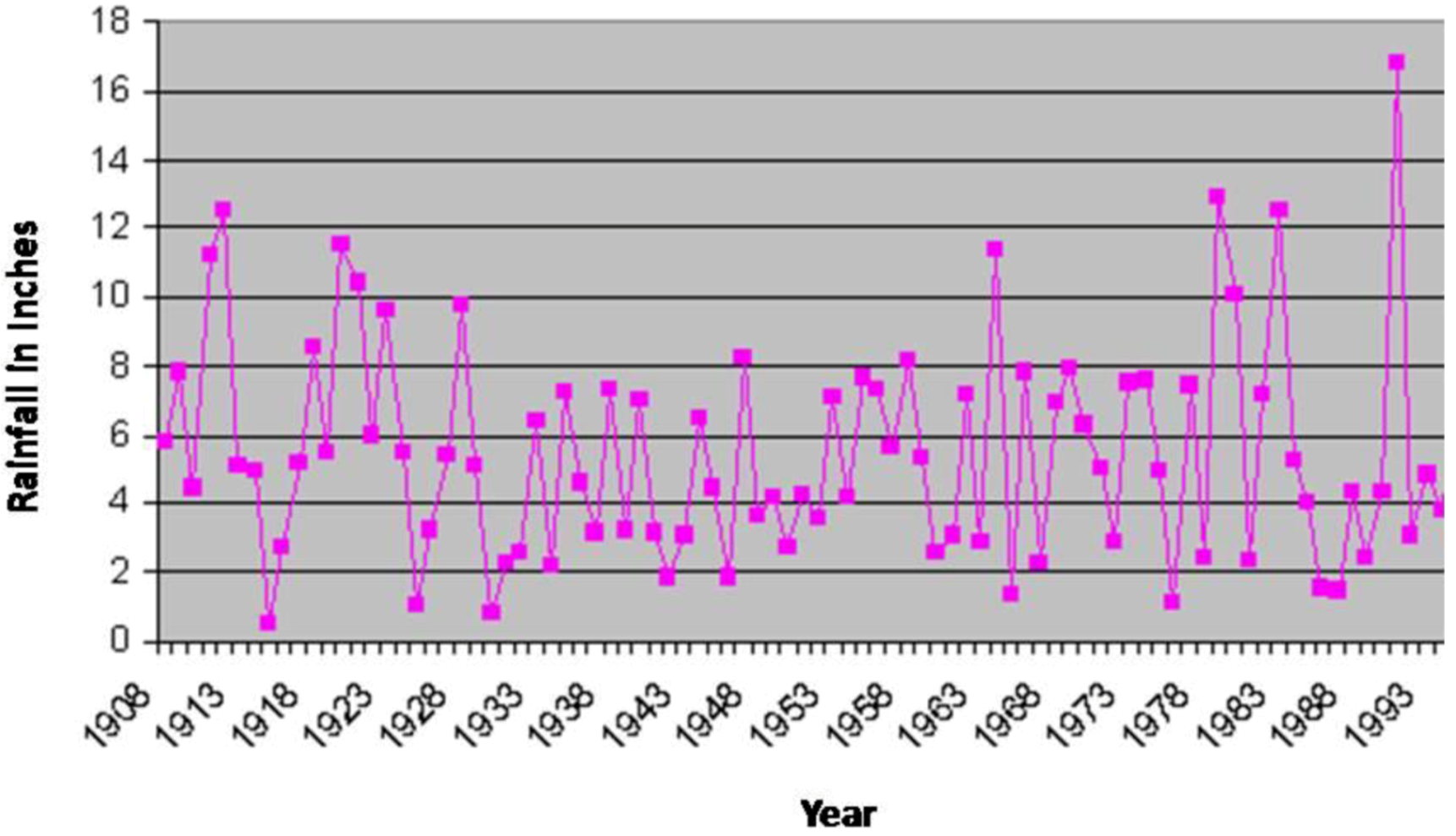
1.1. Background Information
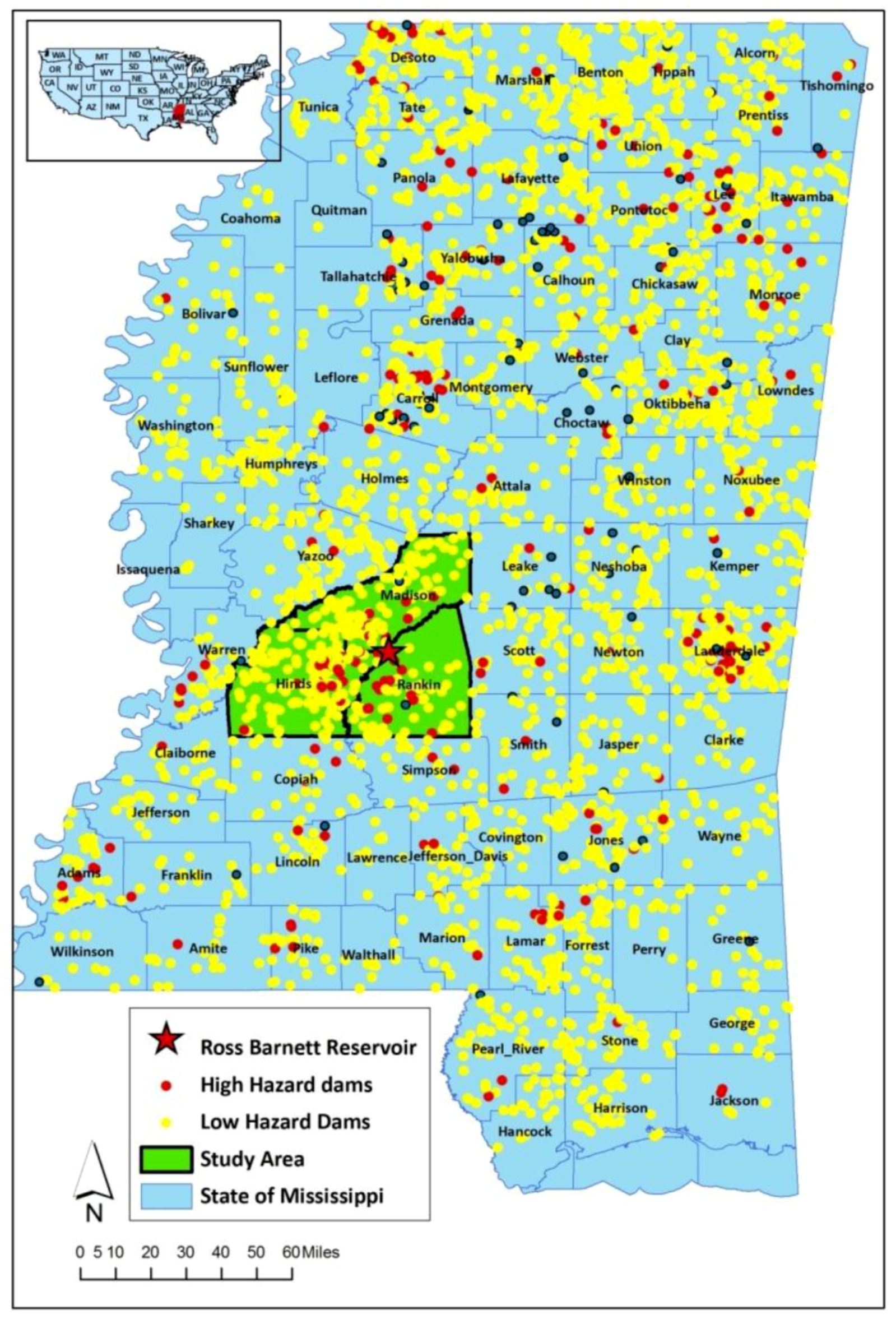
1.2. History of Ross Barnett Reservoir Dam
1.3. Purpose of the Research
1.4. Description of the Simulation Scenario
1.5. Suitability of HEC-RAS for Dam Break Scenario Simulations
1.6. Limitations of Study
2. Methodology
2.1. Simulation of Ross Barnett Reservoir Dam Failure Scenario
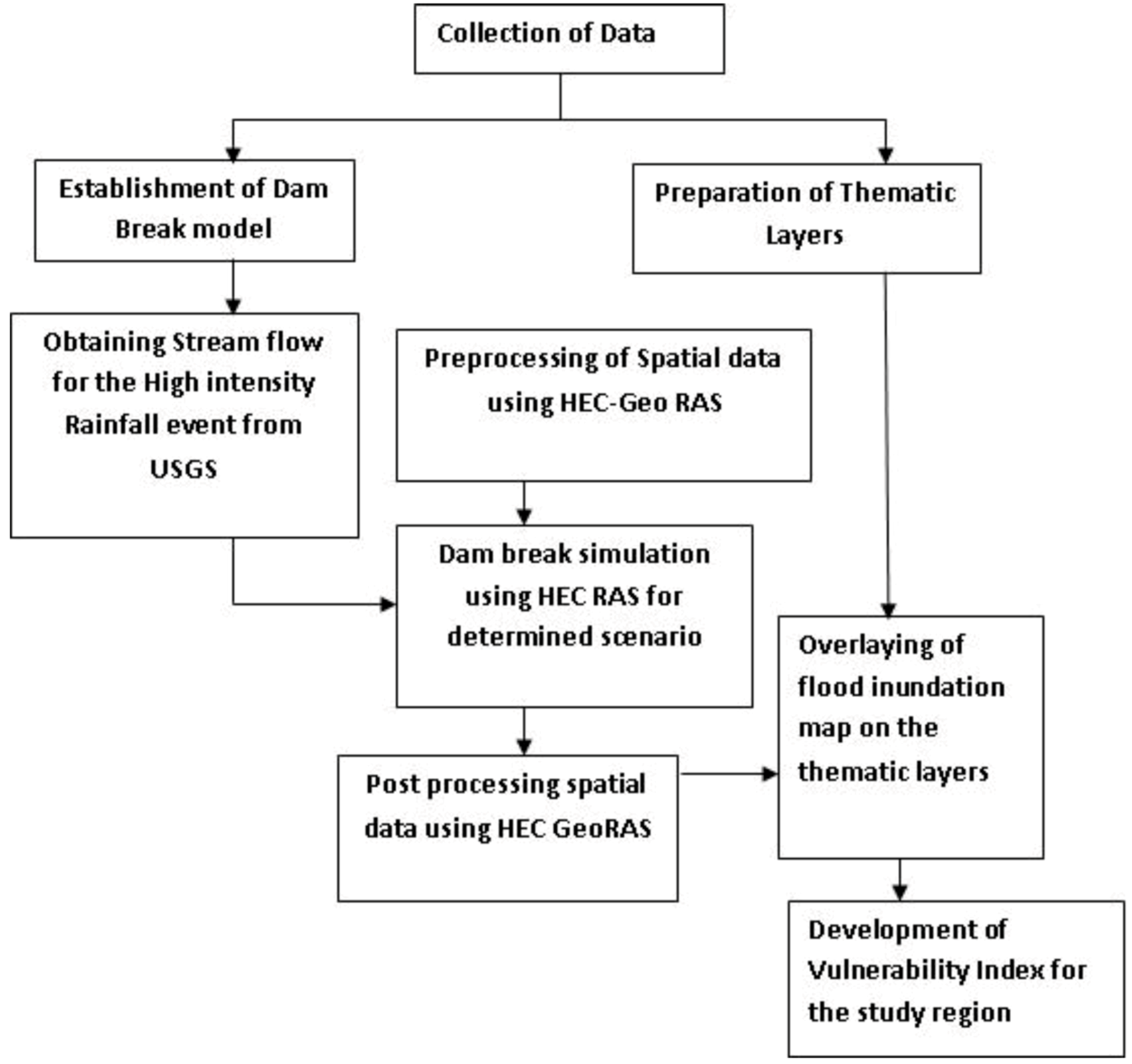
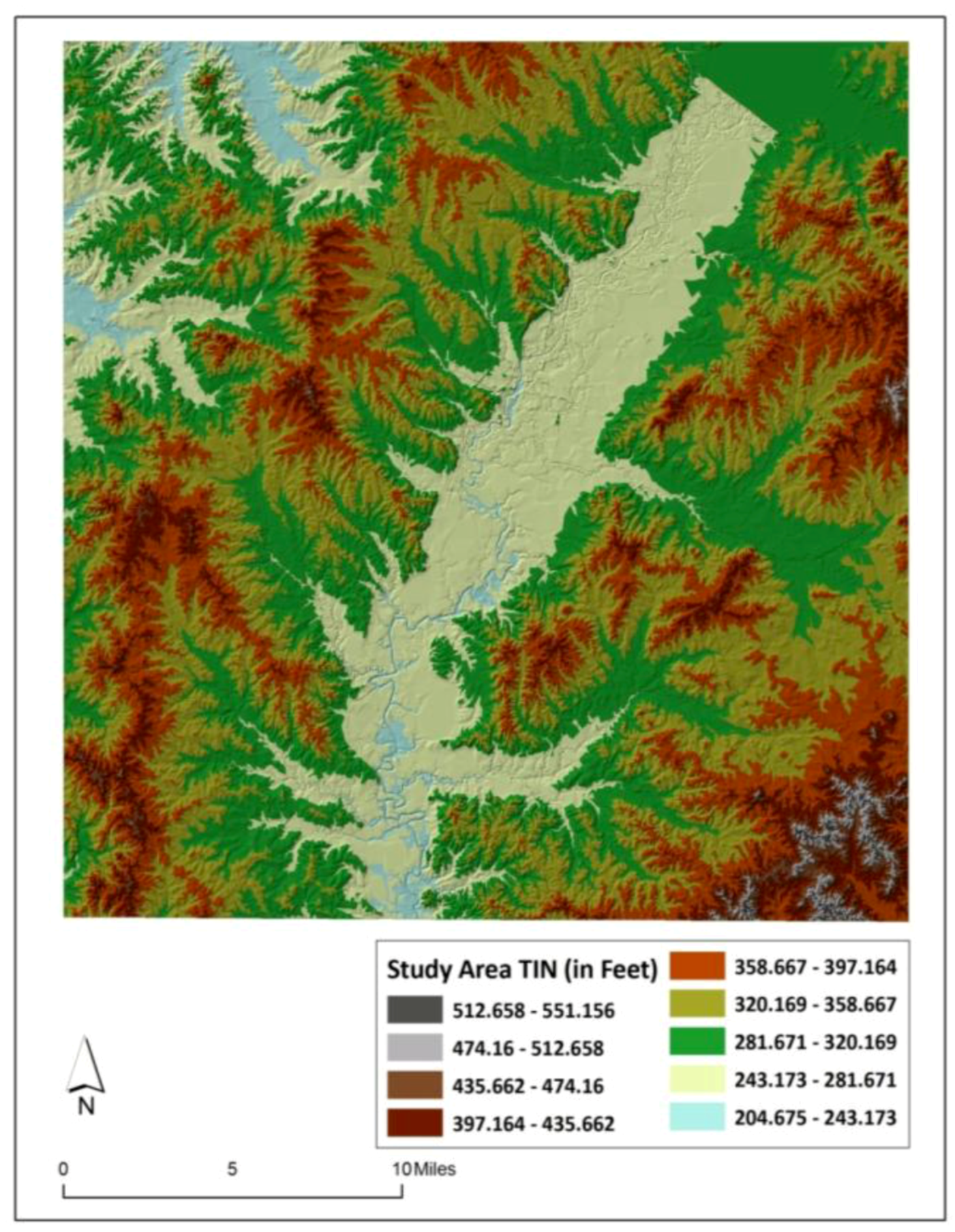
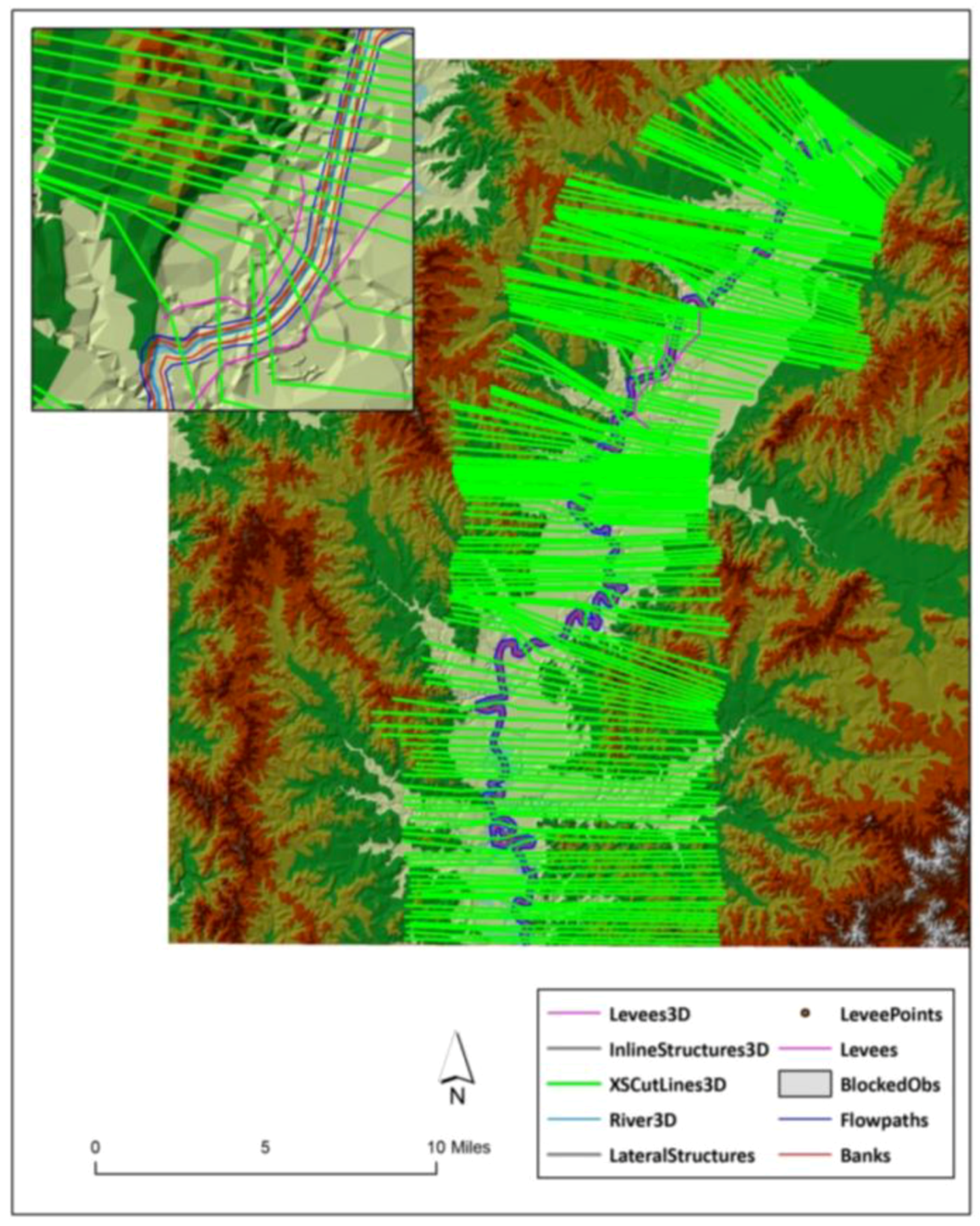
2.2. Inundation Risk Level Assessment

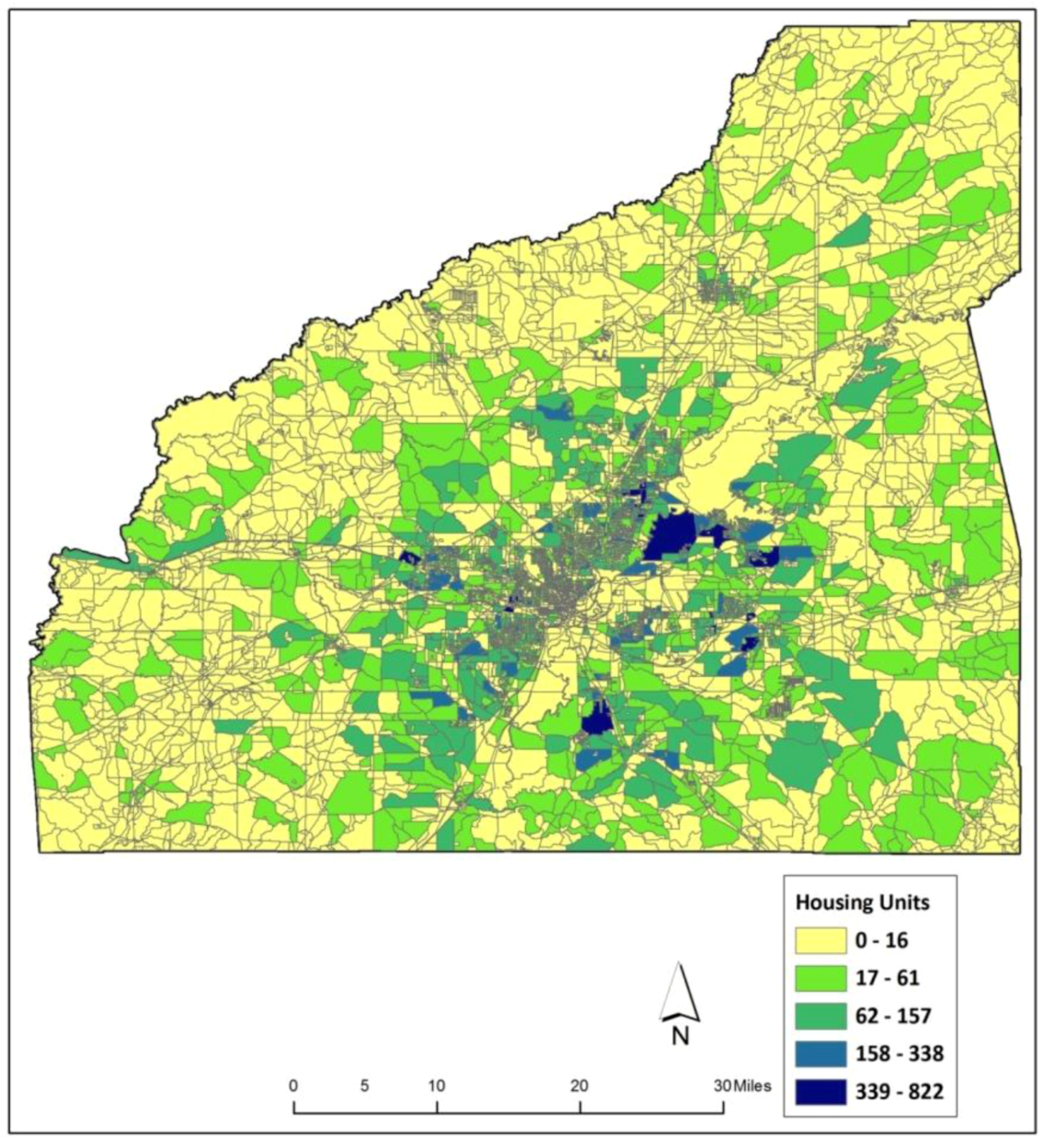
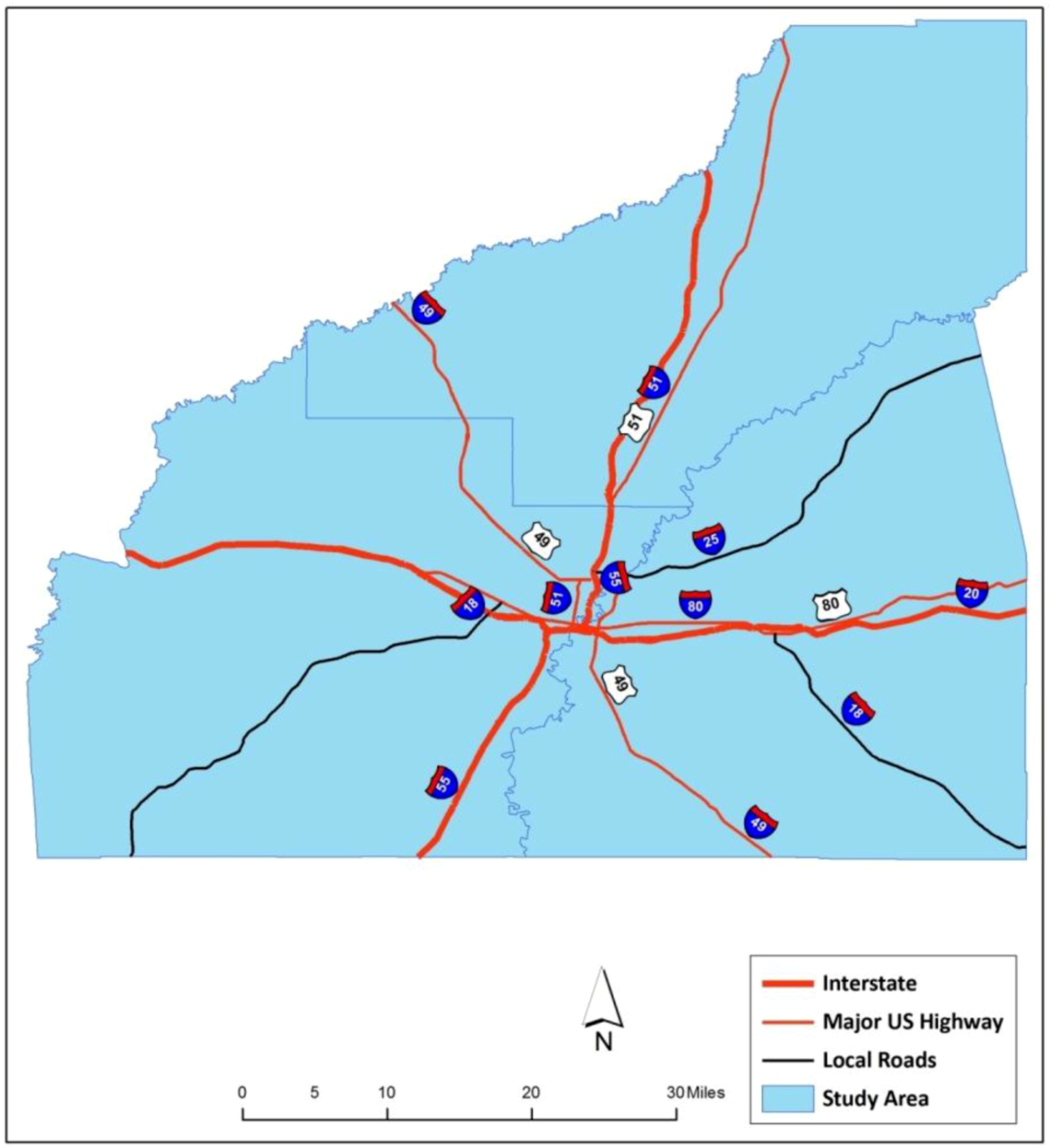
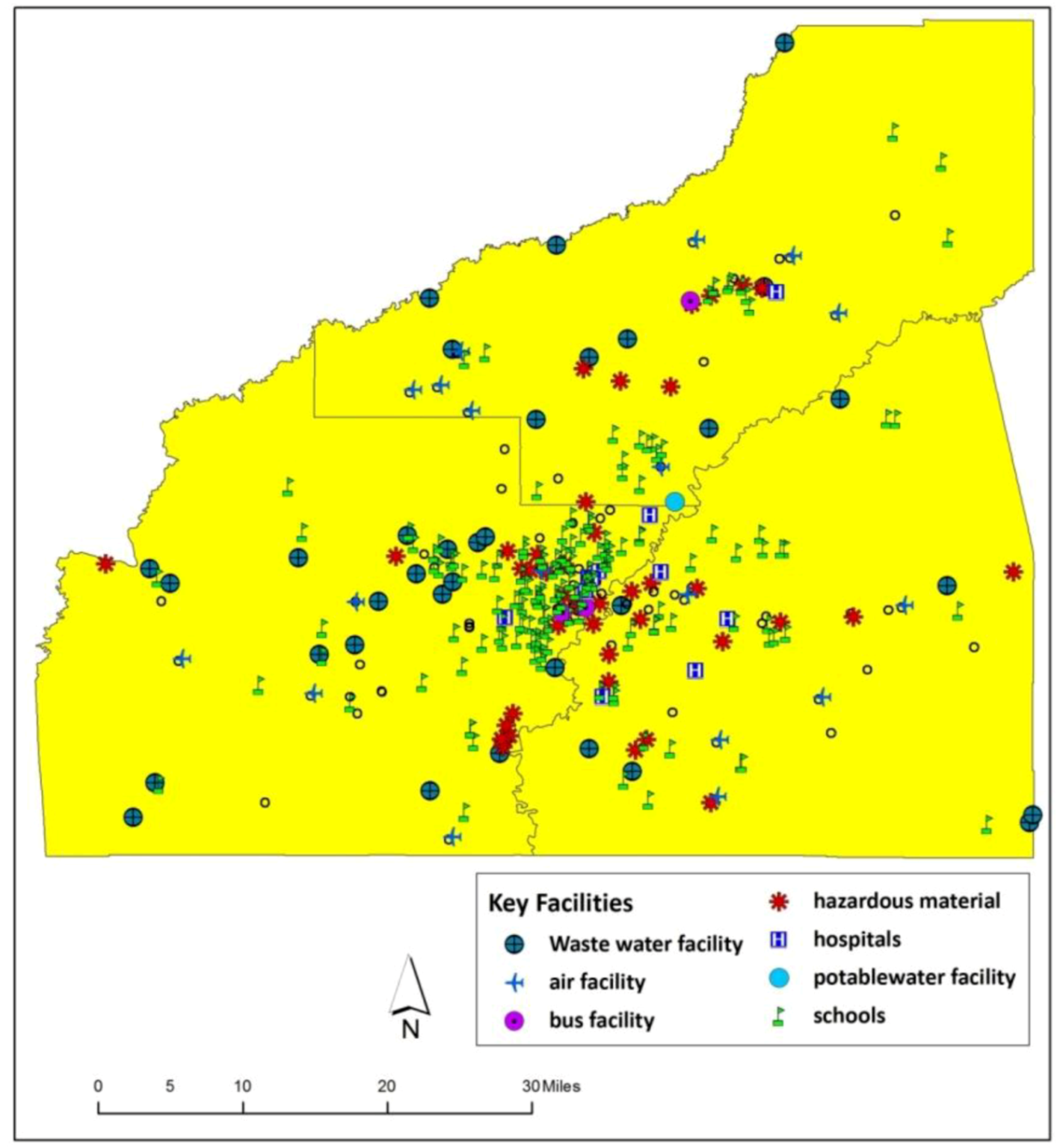
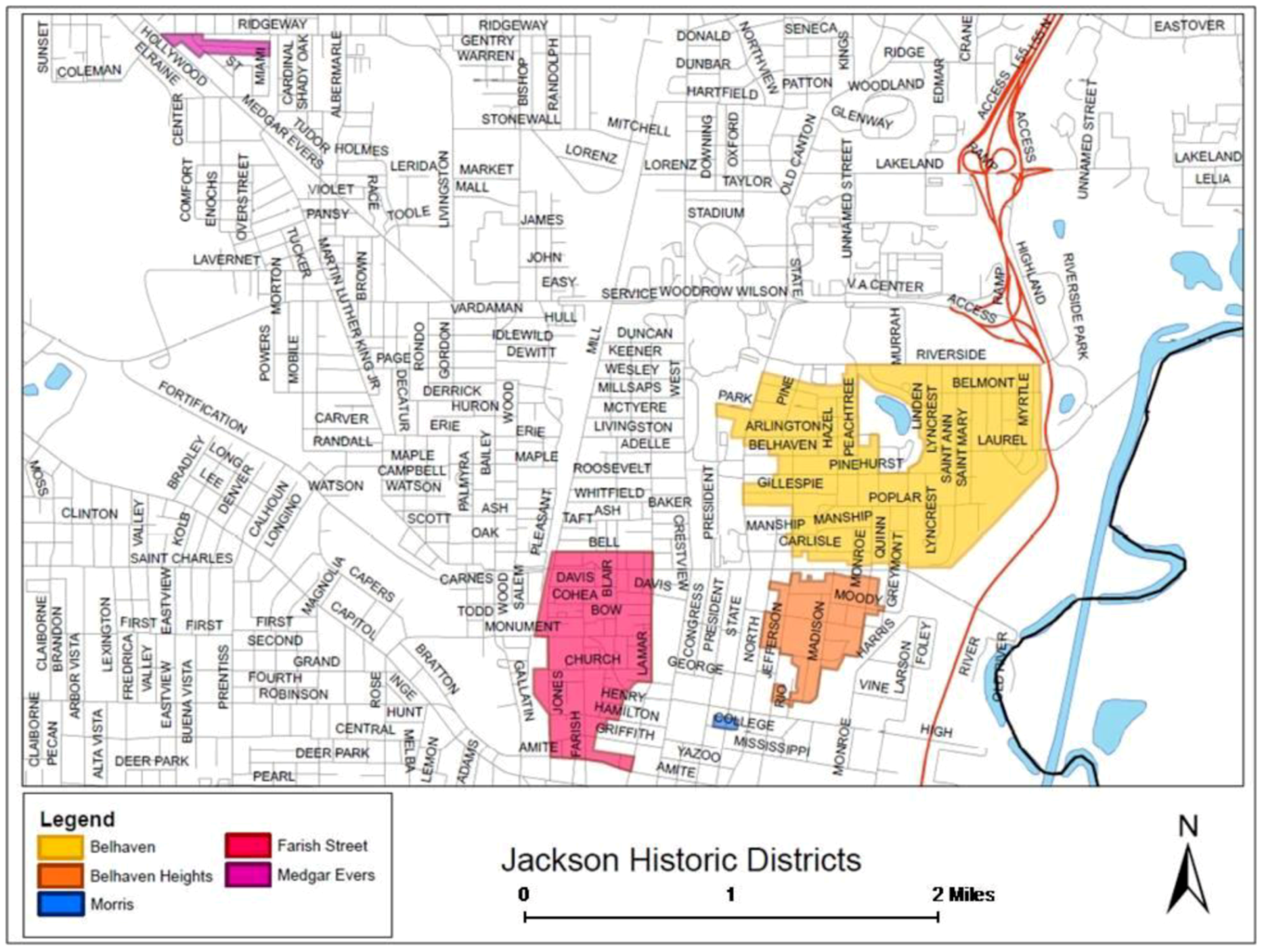
3. Results and Discussion
3.1. Hazard Identification
3.1.1. Spatial Extent
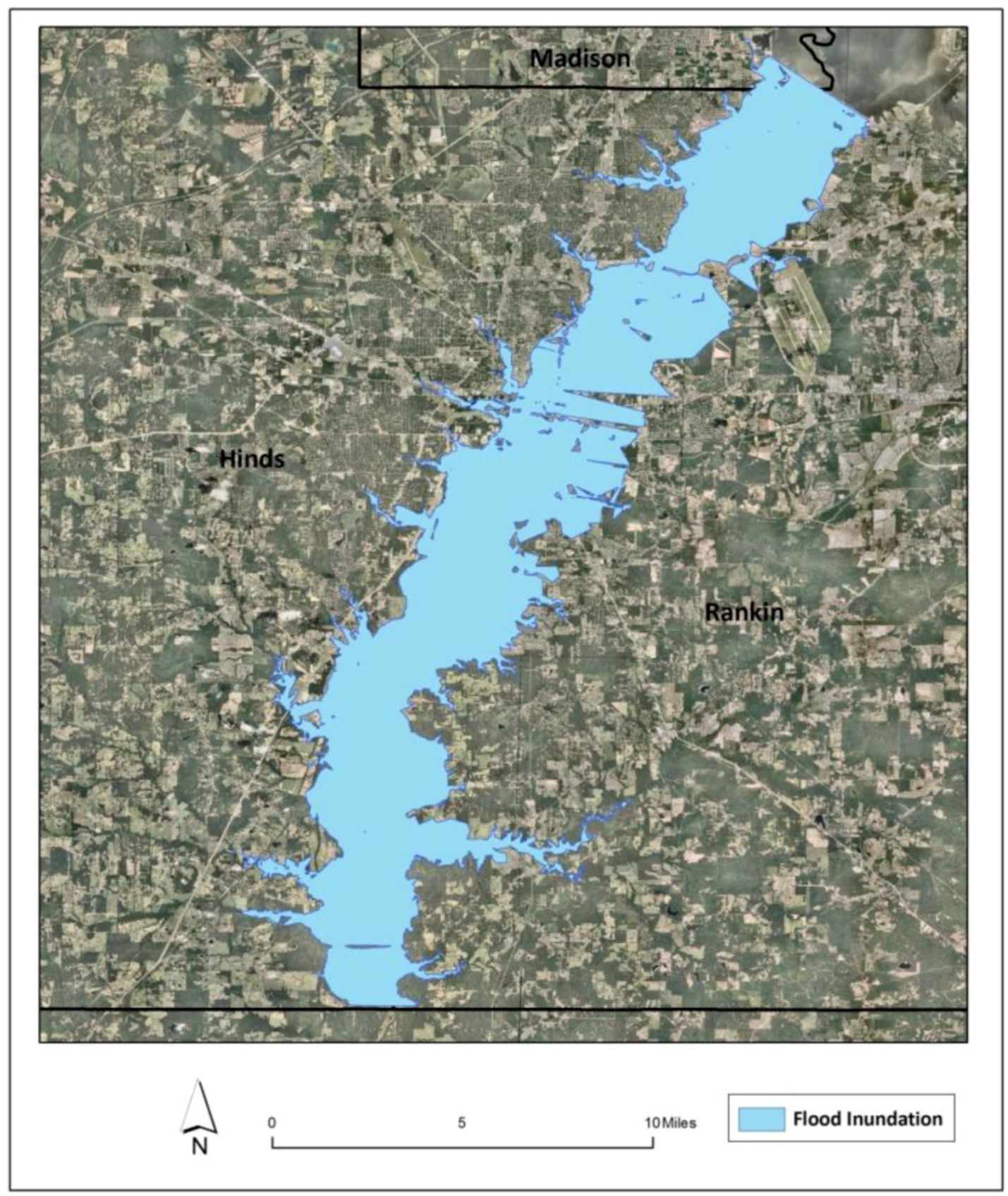
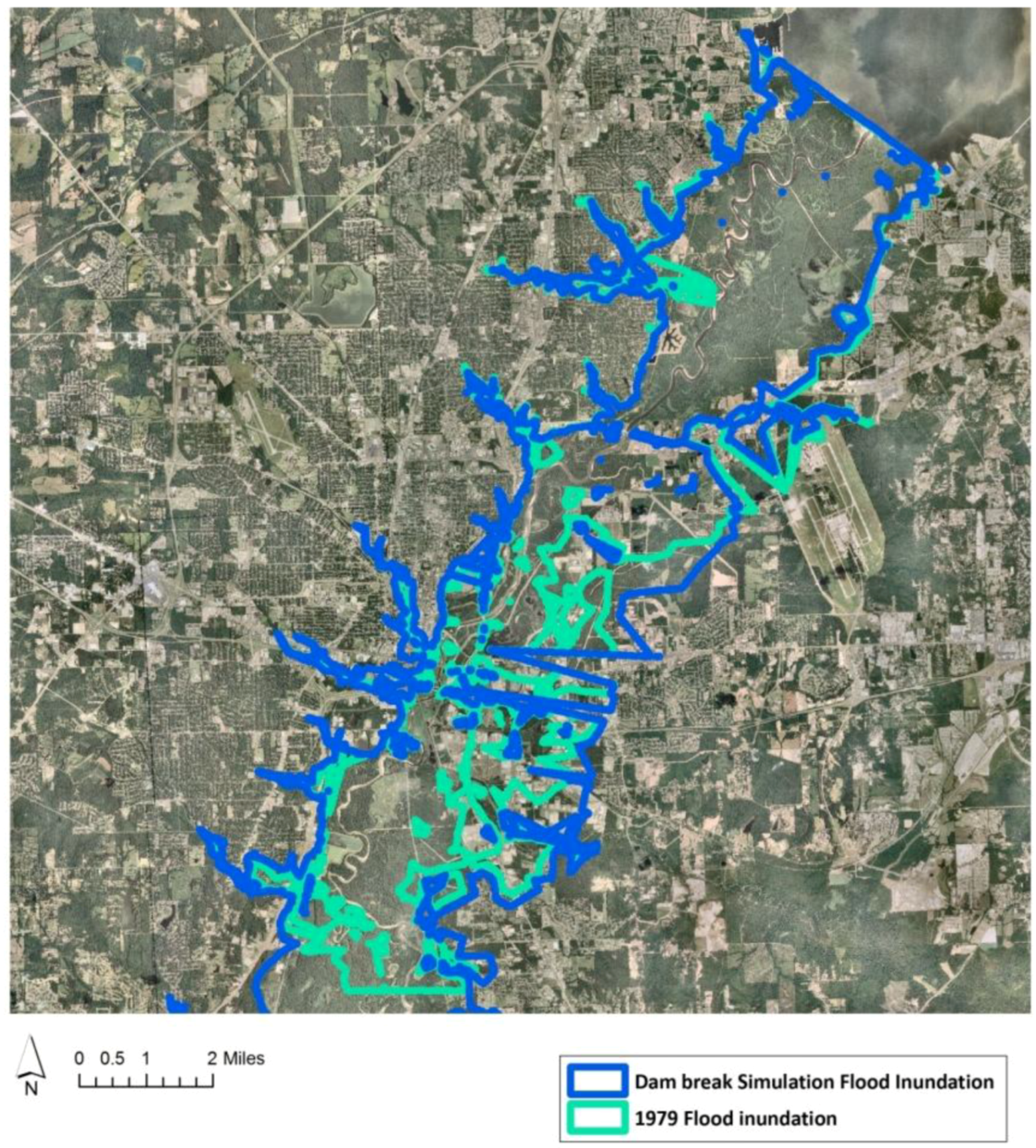
3.1.2. Depth Grids
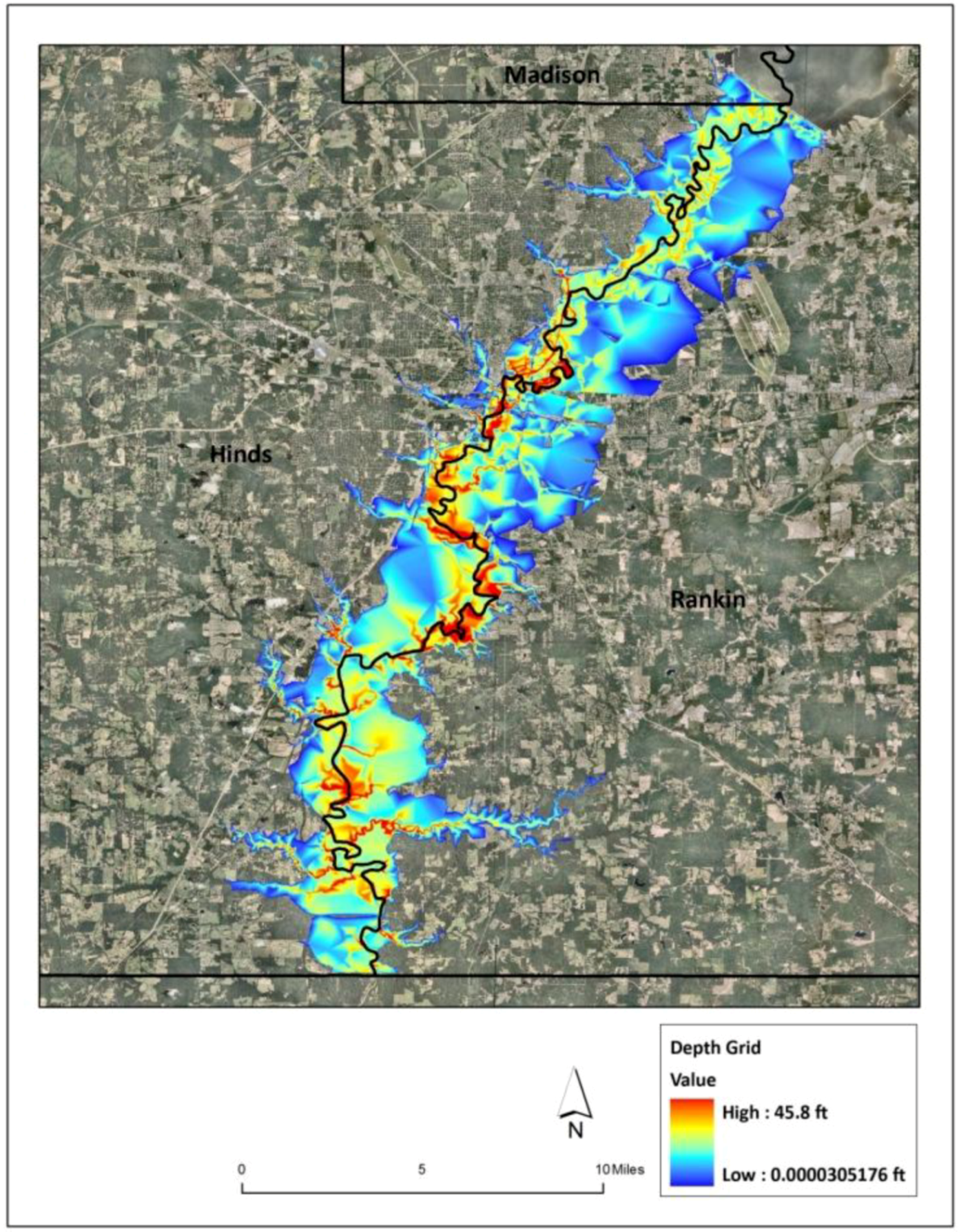
3.2. Vulnerability Assessment
3.2.1. Impact on Cultural and Historical Values
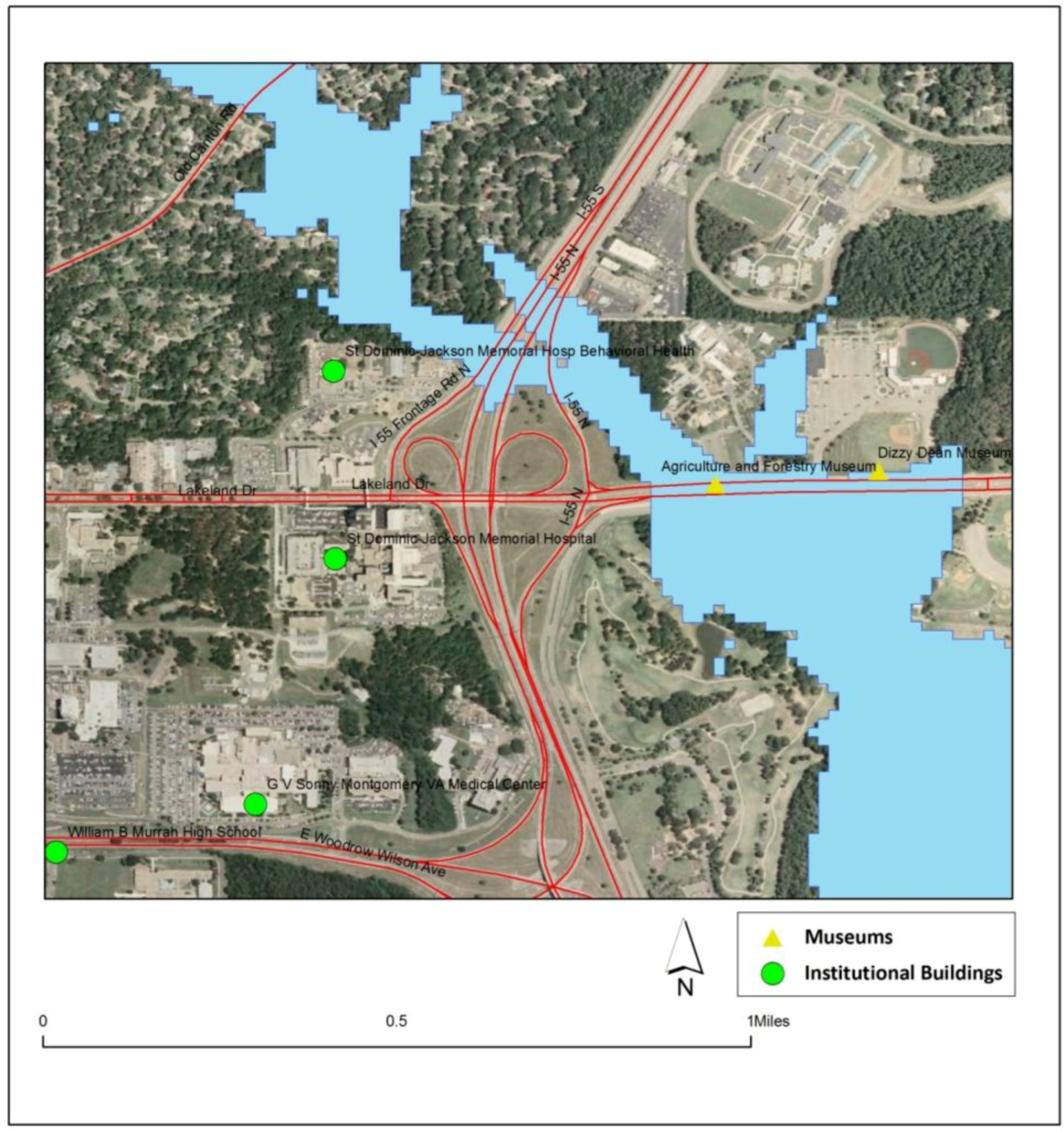
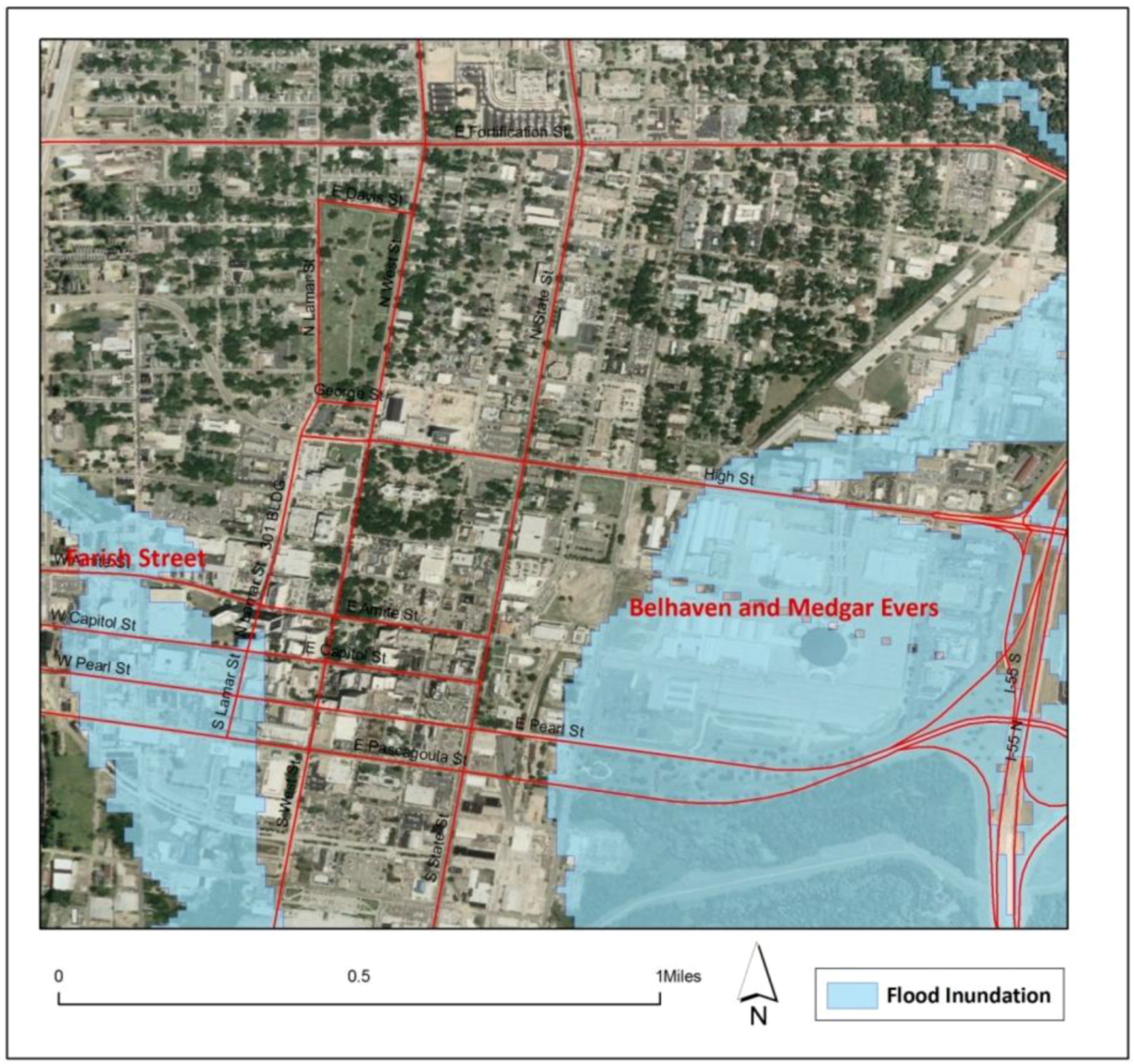
3.2.2. Impact on Social and Infrastructural Facilities
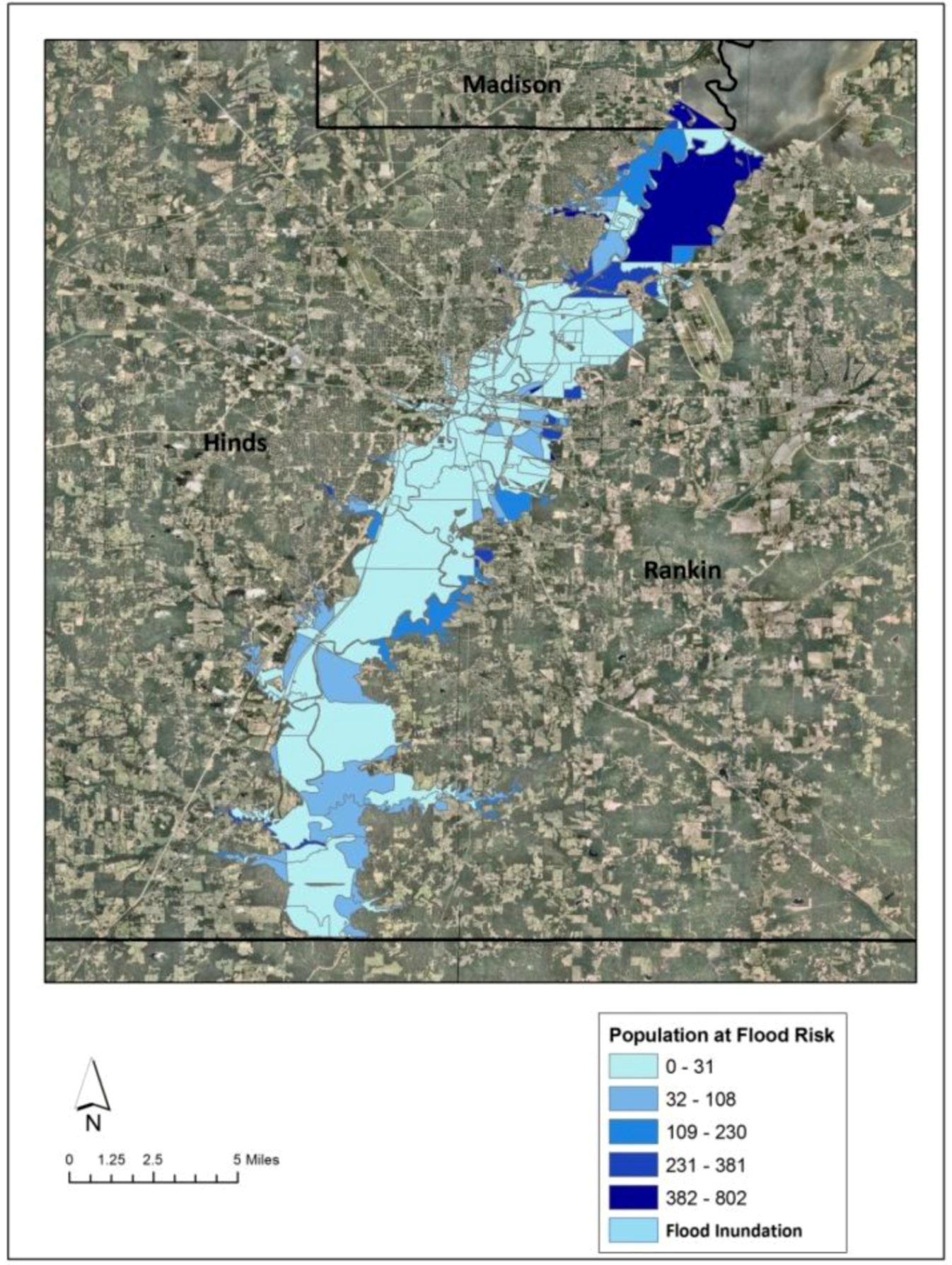
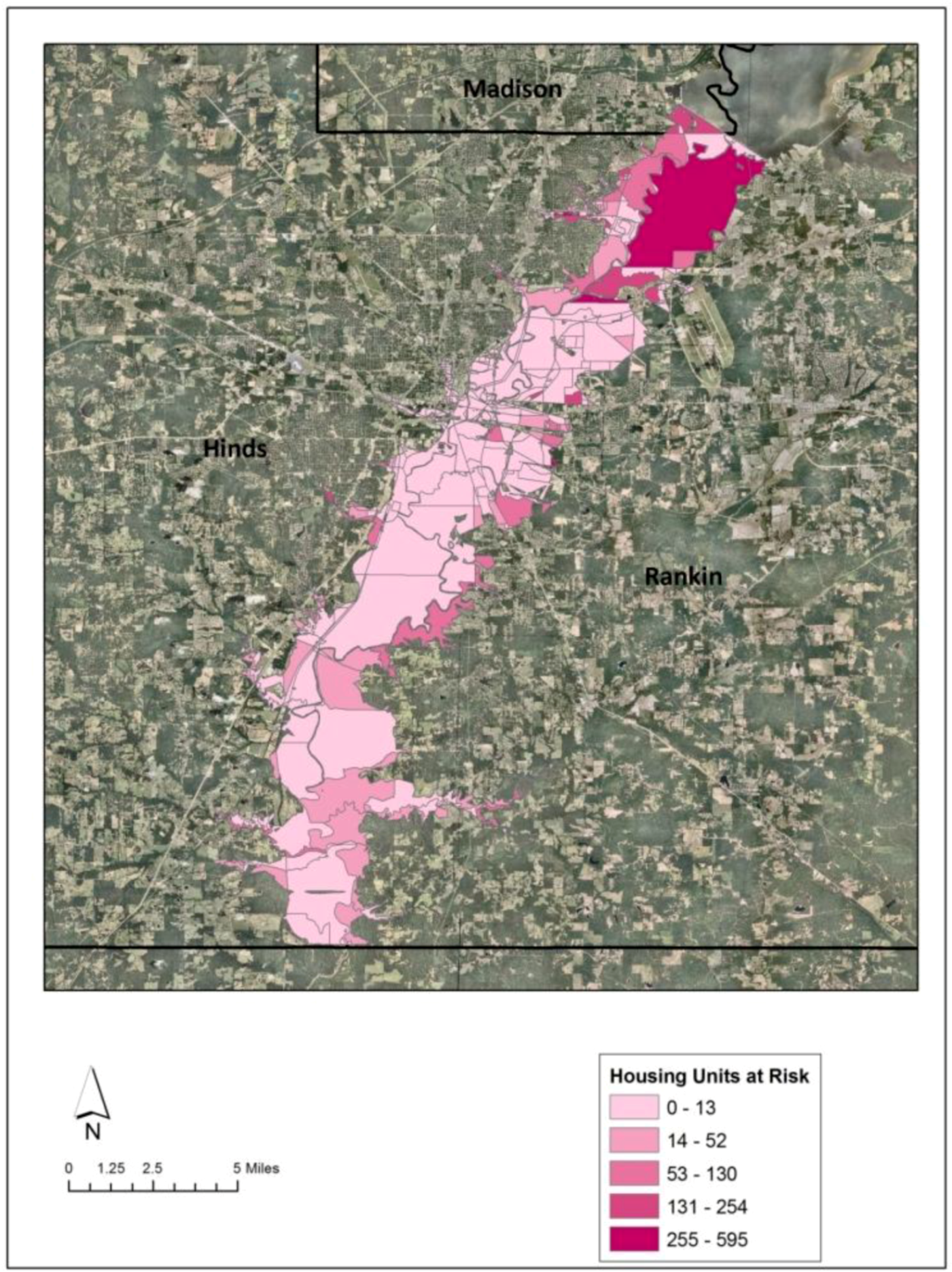
| Total Population Affected Downstream | Hinds County Population Affected | Total Inundated in Downstream (Housing Units) | Total Inundated in Hinds County |
|---|---|---|---|
| 34,100 | 21,660 | 16,279 | 10,384 |
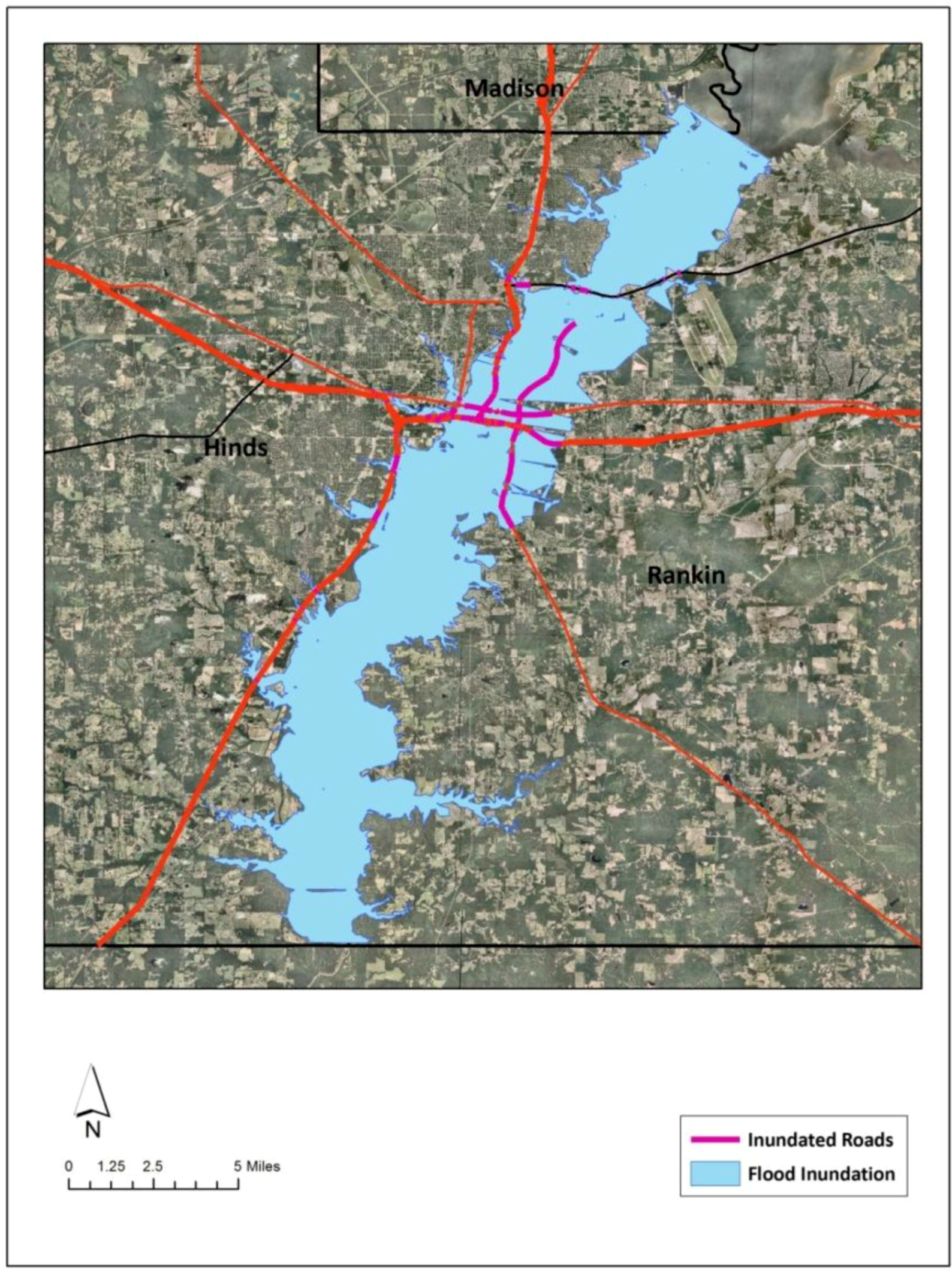
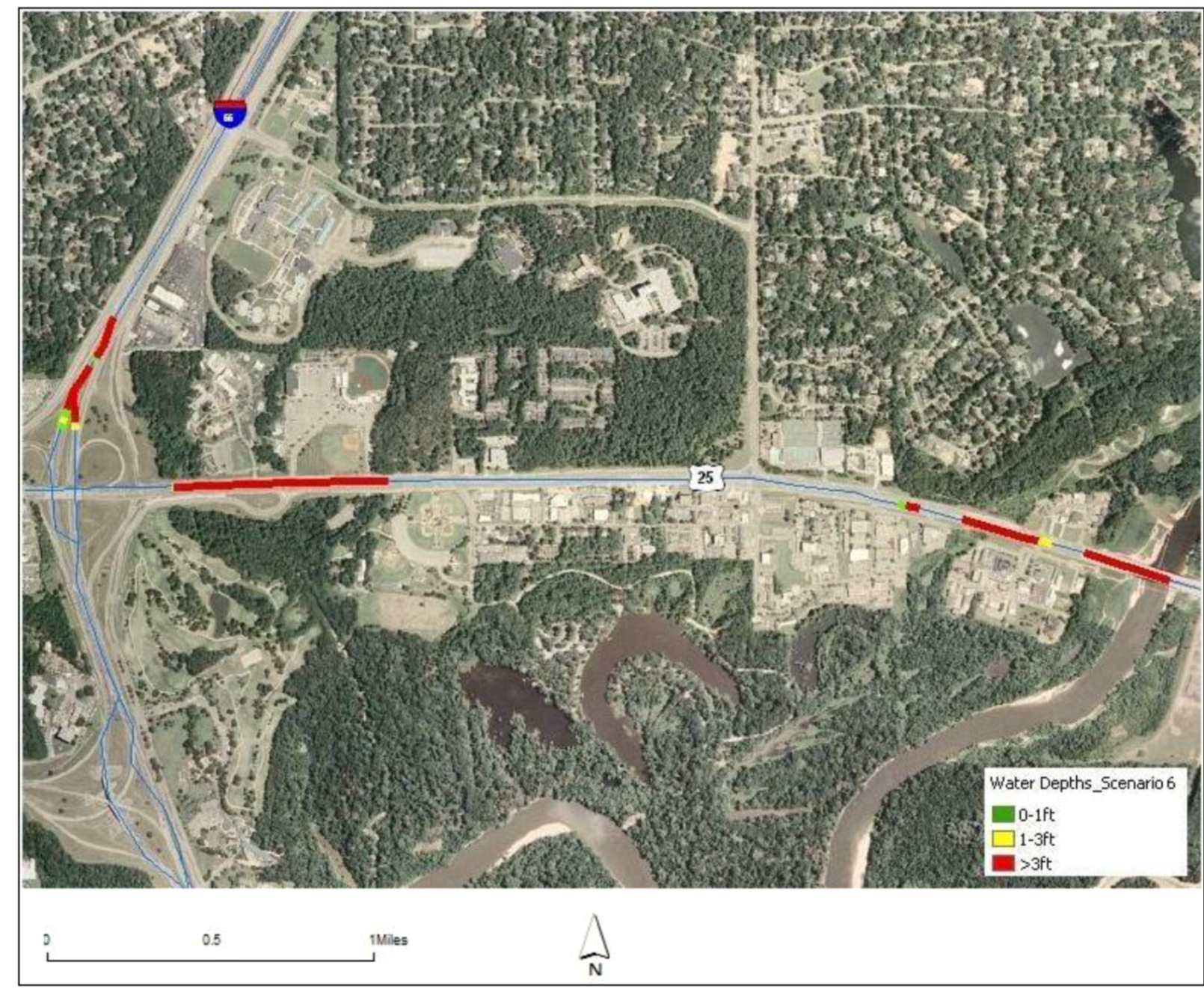
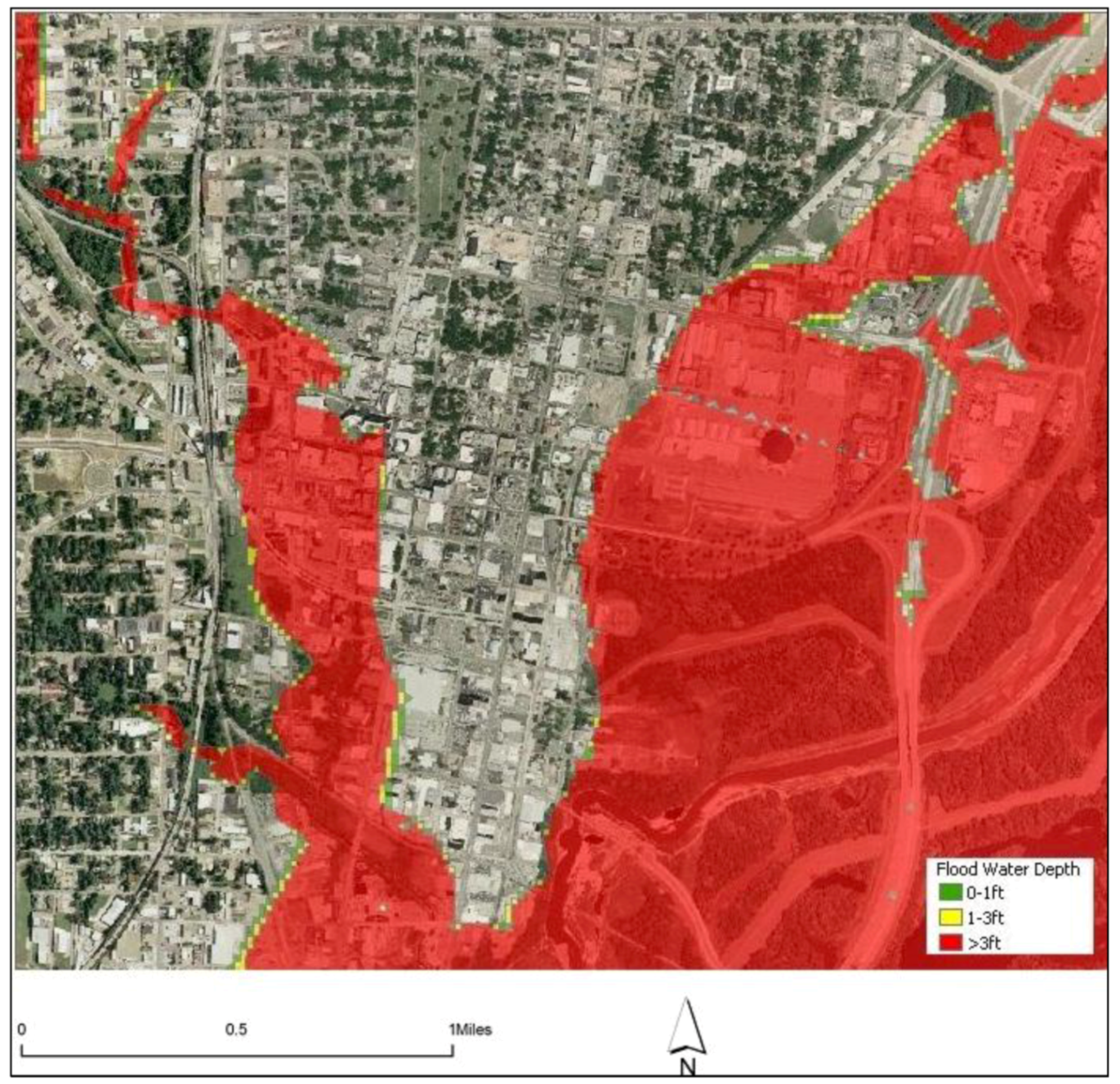
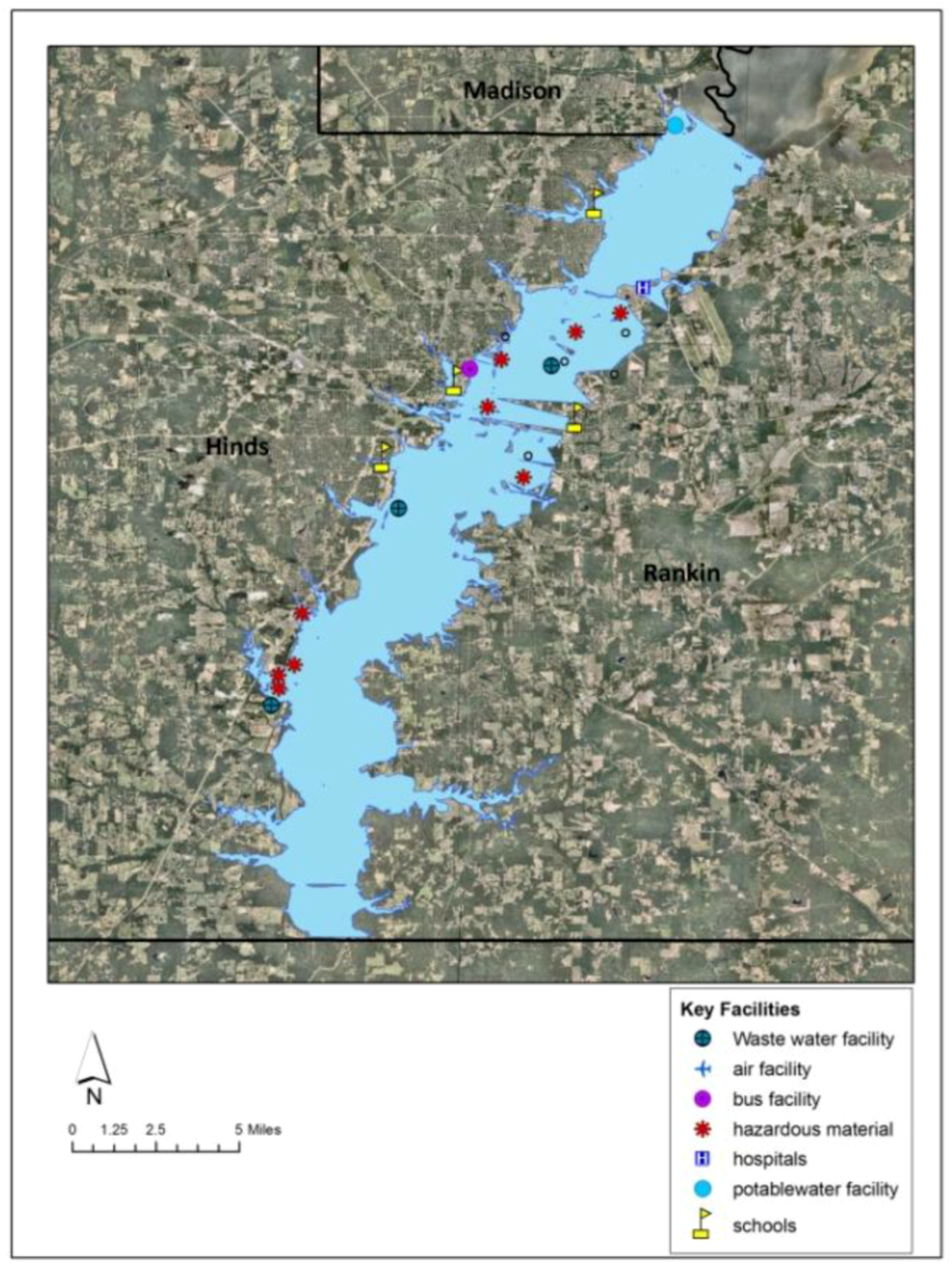
| Key Facilities | Simulation Event |
|---|---|
| Hospitals | 1 |
| Schools | 8 |
| Wastewater Facility | 4 |
| Potable Water Facility | 1 |
| Bus Facility | 1 |
| Communication Facilities | 4 |
| Hazardous Material Plants | 12 |
| Railway Facilities | 2 |
| Total | 33 |
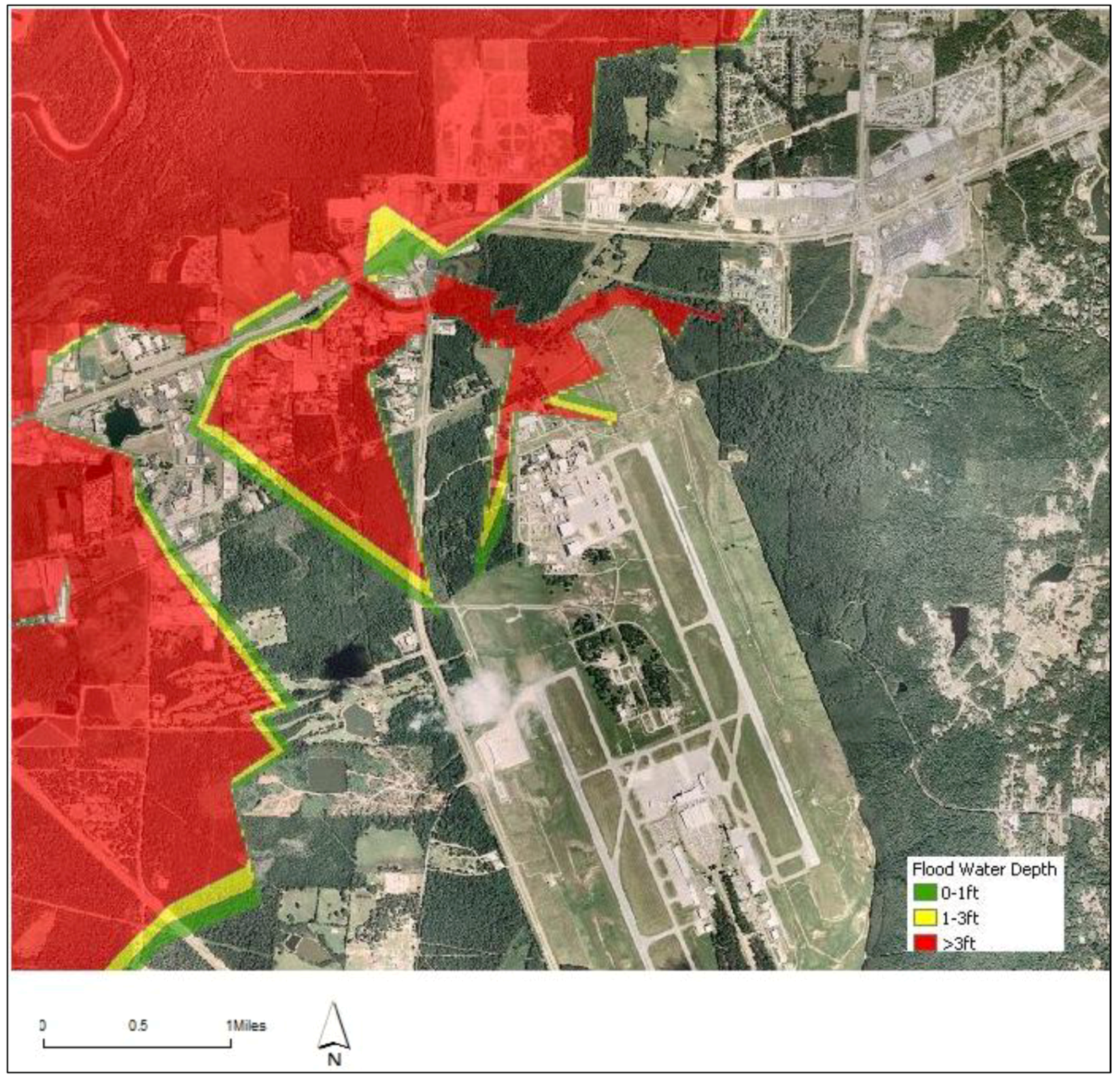
3.2.3. Identification of Highly Vulnerable Blocks in Hinds County
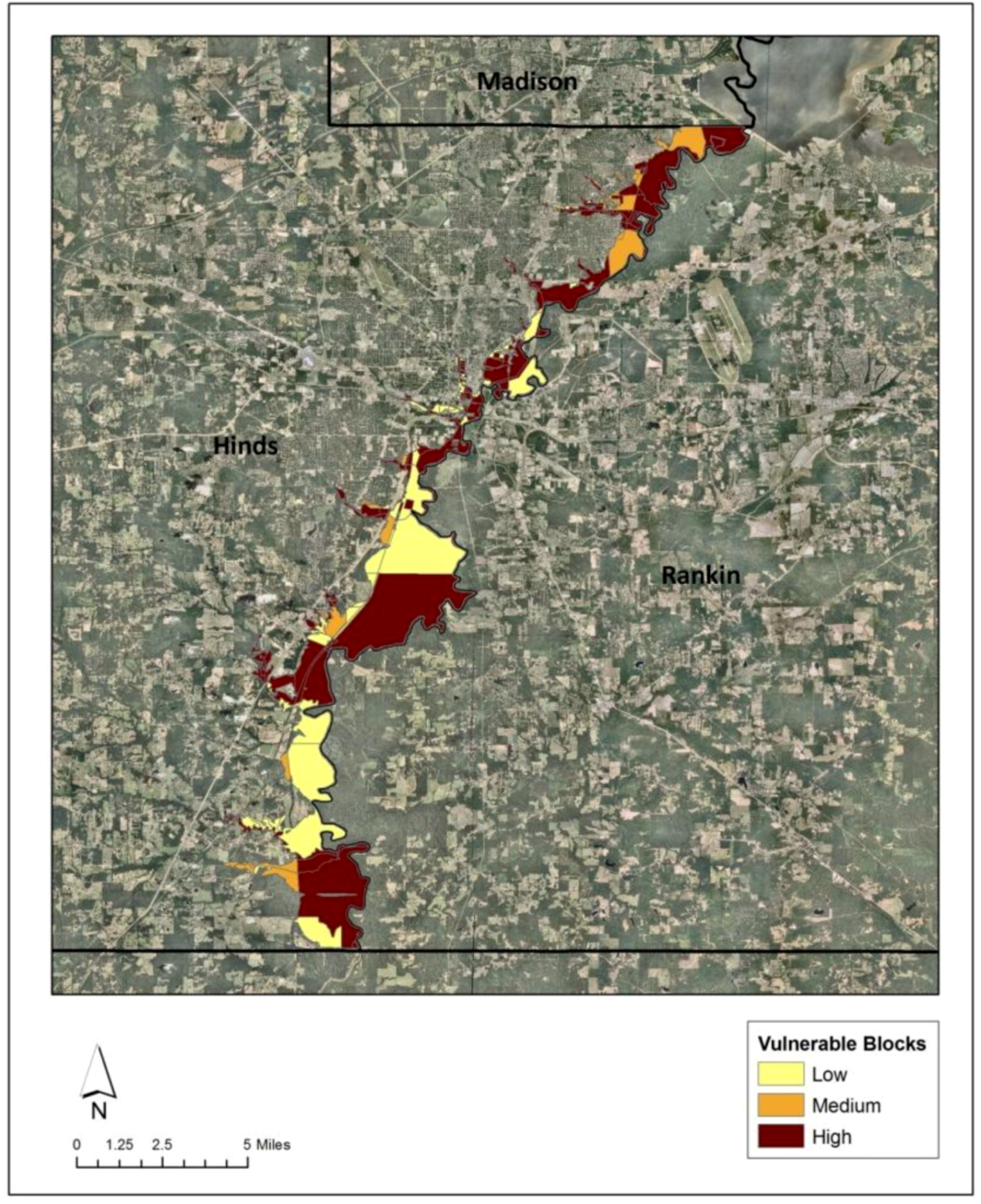
4. Conclusions
References
- IPCC, Summary for Policymakers. In Climate Change 2007: The Physical Science Basis; Solomon, S.; Qin, D.; Manning, M.; Chen, Z.; Marquis, M.; Averyt, K.B.; Tignor, M.; Miller, H.L. (Eds.) Cambridge University Press: Cambridge, UK/New York, NY, USA, 2007; p. 996.
- Easterling, Williams. Adapting North American agriculture to climate change. Agr. Forest Meteorol. 1996, 80, 1–53. [Google Scholar] [CrossRef]
- United States Environmental Protection Agency, Climate Change and Mississippi; US EPA: Washington, DC, USA, 1998.
- City of Roseville. Dam Failure. Available online: http://www.roseville.ca.us/civica/filebank/blobdload.asp?BlobID=19067 (accessed on 19 November 2012).
- Zhu, N.H.; Turner, E.R.; Doyle, T.; Abdollahi, K. The Potential Consequences of Climate Variability and Change; GCRCC and LSU Graphic Services: Baton Rouge, LA, USA, 2003. [Google Scholar]
- FEMA. Grants Target Mississippi Flood Risks. Available online: http://www.fema.gov/news-release/grants-target-mississippi-flood-risks (accessed on 21 August 2012).
- Idaho National Laboratory, Assessment of Potential Flood Events and Impacts at INL’s Proposed Remote-Handled Low-Level Waste Disposal Facility Sites; US Department of Energy: Idaho Falls, ID, USA, 2010.
- Jami, E.; Scuddkr, M.; Johan, G.; Wilfrid, G. Lessons from a dam failure. J. Sci. 2000, 100, 121–131. [Google Scholar]
- Proactive Measures Needed to Prevent Future Dam Disasters; Association of State Dam Safety Officials: Lexington, KY, USA, 2004.
- US Army Corps of Engineers. Pearl River Watershed Study. 2004. Available online: http://www.mvk.usace.army.mil/offices/pp/projects/prws/background.htm (accessed on 17 August 2012).
- Rutherford, P.H. The Jackson Flood of 1979 a public policy disaster. J. Amer. Plan. Assn. 1982, 48, 219–231. [Google Scholar] [CrossRef]
- MSMEMA, The State of Mississippi Standard Mitigation Plan; MSMEMA: Jackson, MS, USA, 2012.
- Katopodes, N.D. Two dimensional Surges and shocks in open channels. J. Hydraul. Div. 1984, 110, 794–812. [Google Scholar] [CrossRef]
- Hromadka, T.V.; Berenbrock, C.E.; Freckleton, J.R.; Guymon, G.L. A two dimensional dam-break flood plain model. Adv. Water Resour. 1985, 8, 7–14. [Google Scholar] [CrossRef]
- Akbani, A.A. Model for flood propagation on initially dry land. J. Hydraul. Eng. 1988, 114, 689–706. [Google Scholar] [CrossRef]
- Zhao, D.H. Approximate riemann solver in FVM for 2D hydraulic shock wave modeling. J. Hydraul. Eng. 1996, 122, 692–702. [Google Scholar] [CrossRef]
- Sharma, A.K. A Study of Two-Dimensional Flow Propagating from an Opening in the River Dike; Gauhati Univeristy: Gauhati, India, 1999. [Google Scholar]
- Zoppou, C.; Robert, S. Numerical solution of the two dimensional unsteady dam break. Appl. Math. Model 2000, 24, 457–475. [Google Scholar] [CrossRef]
- Davies, T.R.; Scott, B.K. Dam break flood hazard from the Callery River. J. Hydrol. 1997, 36, 1–13. [Google Scholar]
- New Zealand Institute of Water and Atmospheric Research. In A Methodology to Assess the Impacts of Climate Change on Flood Risk in New Zealand; Ministry of Environment: Wellington, New Zealand, 2005.
- Bernardo, R.; Ramos, I. GIS in Flood Risk Management. Available online: http://libraries.maine.edu/Spatial/gisweb/spatdb/egis/eg94056.html (accessed on 11 August 2009).
- Bajwa, H.S.; Tim, U.S. Toward immersive virtual environments for GIS-based Floodplain modeling and Visualization. In Proceedings of 22nd ESRI User Conference, San Diego, TX, USA, 8–12 July 2002.
- Cameron, A.T. Geo Spatial Capabilities of HEC RAS for Model Development and Mapping. In Proceedings of 2nd Joint Federal Interagency Conference, Las Vegas, NV, USA, 27 June–1 July 2010.
- Hicks, F.E.; Peacock, T. Suitability of HEC-RAS for flood forecasting. Can. Water Res. J. 2005, 30, 159–174. [Google Scholar] [CrossRef]
- Cameron, A.T.; Gary, W.; Brunner, P.E. Dam Failure Analysis Using Hec-Ras And Hec-Georas. Available online: http://www.gcmrc.gov/library/reports/physical/Fine_Sed/8thFISC2006/3rdFIHMC/11F_Ackerman.pdf (accessed on 23 September 2008).
- Morris, G.L. Dam Break Flood Hazard Analysis for Quebrada Beatriz Reservoir; Puerto Rico Infrastructure Financing Authority: Caguas, Puerto Rico, 2007. [Google Scholar]
- City of Jackson. Historic Districts. Available online: http://www.jacksonms.gov/assets/planning/historic%20districts.pdf (accessed on 24 August, 2009).
- Burby, R.J. Cooperating with Nature: Confronting Natural Hazards with Land Use Planning for Sustainable Communities; Joseph Henry/National Academy Press: Washington, DC, USA, 1998. [Google Scholar]
- Geertman, S.; Stillwell, J. Planning Support Systems: An Introduction. In Planning Support Systems in Practice; Springer: Berlin, Germany, 2003; pp. 25–55. [Google Scholar]
- Yerramilli, S. A hybrid approach of integrating HEC-RAS and GIS towards the identification and assessment of flood risk vulnerability in the city of Jackson, MS. Am. J. Geogr. Inform. Syst. 2012, 1, 7–16. [Google Scholar]
- Zheng, N.; Takara, K.; Tachikawa, Y.; Kozan, O. Analysis of vulnerability to flood hazard based on land use and population distribution in the Huaihe River basin, China. Ann. Disaster Prev. Restor. 2008, 20, 83–91. [Google Scholar]
- Timothy, C.W. Vulnerability to environmental hazards in the Ciudad Juárez (Mexico)–El Paso (USA) metropolis: A model for spatial risk assessment in transnational context. Appl. Geogr. 2009, 29, 448–461. [Google Scholar] [CrossRef]
© 2013 by the authors; licensee MDPI, Basel, Switzerland. This article is an open access article distributed under the terms and conditions of the Creative Commons Attribution license (http://creativecommons.org/licenses/by/3.0/).
Share and Cite
Yerramilli, S. Potential Impact of Climate Changes on the Inundation Risk Levels in a Dam Break Scenario. ISPRS Int. J. Geo-Inf. 2013, 2, 110-134. https://doi.org/10.3390/ijgi2010110
Yerramilli S. Potential Impact of Climate Changes on the Inundation Risk Levels in a Dam Break Scenario. ISPRS International Journal of Geo-Information. 2013; 2(1):110-134. https://doi.org/10.3390/ijgi2010110
Chicago/Turabian StyleYerramilli, Sudha. 2013. "Potential Impact of Climate Changes on the Inundation Risk Levels in a Dam Break Scenario" ISPRS International Journal of Geo-Information 2, no. 1: 110-134. https://doi.org/10.3390/ijgi2010110
APA StyleYerramilli, S. (2013). Potential Impact of Climate Changes on the Inundation Risk Levels in a Dam Break Scenario. ISPRS International Journal of Geo-Information, 2(1), 110-134. https://doi.org/10.3390/ijgi2010110




